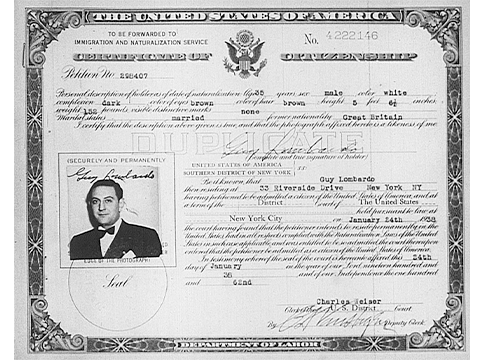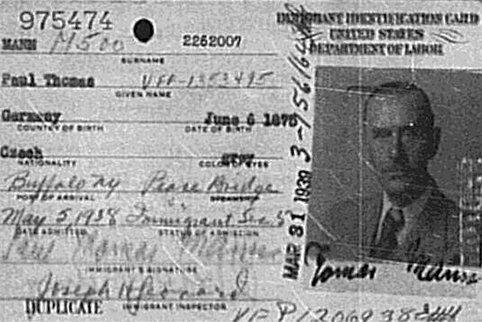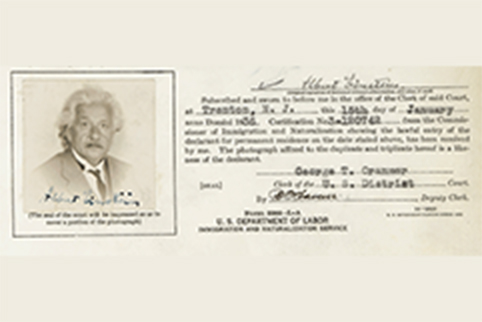I'm an American
INS’s Foray into Radio Broadcasting
Among the most important of USCIS’s missions is promoting citizenship instruction and fostering civic assimilation. Today the agency accomplishes this mission through a variety of print, multimedia, and digital resources, such as the online Citizenship Resource Center. USCIS’s current efforts follow a long history of Immigration and Naturalization Service (INS) citizenship awareness campaigns.

Lombardo appeared on I’M AN AMERICAN in 1941.
The INS gained authority to promote citizenship education in 1918 and over the course of the twentieth century it experimented with novel methods for making immigrants, as well as other Americans, aware of the advantages and duties of American citizenship. In 1940 these efforts took the shape of the I’M AN AMERICAN radio program presented by INS and broadcast over the NBC Radio Network. The USCIS Historical Library holds copies of several scripts from the show.
I’M AN AMERICAN debuted on May 4th, 1940 on NBC’s Red Network with the goal of promoting patriotism and citizenship through interviews with newly naturalized Americans.
The show’s first episode featured the Librarian of Congress, who read a lengthy poem about America. After that the episodes took on a standard format: To start the show, the announcer exclaimed “I’m an American!” and cued a sound effect of a cheering crowd. The announcer then read a short introduction and a Department of Labor or INS official would interview a well-known foreign-born American about his or her experiences in the United States. At the close of the show, the announcer returned and offered a free copy of the Constitution—supplied by the DAR—to any listener who sent a post card to I’M AN AMERICAN, care of the Department of Labor, Washington, DC. Starting in August 1940 the closing announcement also reminded aliens to register at their local post office under the terms of the Alien Registration Act. The show usually ran 15-20 minutes, first on Saturday afternoons and then on Sundays at noon, a time with relatively low listenership.
Despite its not-quite-primetime status, I’M AN AMERICAN attracted several well-known guests from a wide variety of fields including politicians, industrial leaders, academics, novelists, scientists, and performers. For example, episodes featured film director Frank Capra, musician Guy Lombardo, author Thomas Mann, and scientist Albert Einstein, who appeared on the same day that he passed his final citizenship examination. Interviewers from the INS and Department of Labor included

Mann appeared on I’M AN AMERICAN in 1940.
He became a naturalized citizen in 1944.
Assistant Secretary of Labor Marshall Dimock, Deputy Commissioner of INS Edward J. Shaughnessy, and INS legal expert Henry B. Hazard, among others.
The INS called the I’M AN AMERICAN interviews “informal discussions” of Americanism, but the very existence of the scripts belies that claim. INS thoroughly pre-planned each interview. Some of the scripts even show the interviewer’s revision marks, including changes to both questions and the guest’s answers. In one interview, Historian Hendrik Willem Van Loon lampooned the show’s faux spontaneity by threatening to spill water on the scripts to “wash out the letters” so he and his interviewer wouldn’t “know what to say next.” The illusion of informality, according the Van Loon, insulted the listeners, most of who knew that the two of them were reading from “passages heavily underlined in blue pencil” and had planned each pause and laugh beforehand. Ironically, because Van Loon’s interview depended on a choreographed argument it appears even more elaborately scripted than others.
Though it’s not clear from the scripts how much content the guests supplied, it is clear that the show attempted to convey specific messages about citizenship. The show featured naturalized citizens but it did not focus narrowly on naturalization or citizenship education. Instead, I’M AN AMERICAN presented messages about citizenship that applied to both US born citizens and immigrants alike.
The show’s foremost theme was America’s role as a beacon of freedom, equality, and tolerance. Though the show debuted before the U.S.’s entry into WWII, by May 1940 it had become apparent to many that the U.S. would eventually join the fighting. I’M AN AMERICAN became part of a government-wide effort to mobilize national morale behind the cause of national defense. The show presented the American way of life as superior to the alternatives offered by European regimes and used immigrants who fled those countries to make the point. For example, when asked why he left Germany and settled in the U.S., Einstein explained, “as long as I have any choice I will only stay in a country where political liberty, toleration, and equality of all citizens before the law is the rule.”
The interviews often addressed the war in Europe directly in order to highlight the differences between life there and in the US. In one remarkable example, cartoonist and puppeteer Tony Sarg had his marionette “Punch” remark, “I heard them say that in some countries of the world they were making puppets out of men and women nowadays instead of wood. I heard they could make them march and salute with their arms out stiff and straight-so, the way a puppet would do it… It sets me a shaking in every joint and string to think of it! Puppets of flesh and blood!”

I’M AN AMERICAN promoted national unity but it did so in a pluralistic way, avoiding the idea of strict assimilation for a vision of America as a collection of peoples who contributed their own strengths and traditions to the greater good. For example, guest Eleanor Roosevelt reminded immigrants “never to forget your own cultural background and use whatever skills and culture that background gives you to enrich what you acquire in the United States.” This celebration of ethnic difference, however, was accompanied by the warning that “totalitarian” countries could take advantage of those differences and divide America against itself. Thus, the interviews also highlighted the importance of shared unity among America’s ethnic groups.
Because I’M AN AMERICAN debuted during the Great Depression, the show also portrayed the U.S. as a continuing land of opportunity. Several interviewees mentioned that their successes depended on a freedom to pursue their dreams in ways not possible in their homelands. Others focused on the social mobility afforded by hard work. William Knudsen, the auto executive and naturalized citizen Franklin D. Roosevelt appointed to head the National Defense Commission’s production planning, succinctly summed up this attitude by saying, “if you want work and will hustle out and take what you can get and not sit around and wait for a fancy job to be brought to you, you can find plenty of opportunities.”
I’M AN AMERICAN remained on the air until December of 1941 and in 1942 and 1943 returned for shorts stints focused around “I am an American Day” (a precursor to Citizenship Day). A unique mix of pre-war propaganda and engaging interviews, it remains one of
*Note: Sound recordings of I’M AN AMERICAN are available from the NBC Radio Collection in the Library of Congress.
